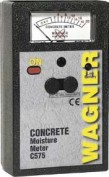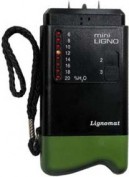Search This Site
Search With Google
Salt in the damp moisture will actually cause a microscopic attack on the masonary materials. As moisture evaporates, the salts will crystallise. This process causes pressure in the masonary that surrounds each salt crystal. Over time , and as the process repeats itself, masonary will break down in layers. Some specific salts will even cause a chemical reaction that will also destroy the internal structure of masonary materials.
Salt Damp -
An electrical moisture meter when used will respond to small amounts of moisture and certain salts. In building materials theses salts are hygroscopic , which means that they absorb moisture from the surrounding atmosphere. If the atmoshere is of high humidity then the greater the amount of moisture is absorbed. The greater the concentration of salts as well will result in a greater absorption of moisture. If a wall is contaminated with salts and a lack of free moisture there, the wall will appear to be dry visibly. But if tested with a moisture meter you will get a high moistent content reading. If contamination is high and has got in to any decorative finishes, at times a wall can look very damp solely because of moisture absorption from the air. This is what salt damp is.
How it looks though is dependant upon the surrounding humidity and whether or not the salts get in to the finish of a wall. With standard wallpaper this easily occurs as salt damp is permeable. With vinyl wallpapers, dampness is rarely visible as the surface is relatively impermeable. Vinyl wallpapers will tend to bubble as the adhesive behind it softens and the paper backing expands.
A quick way to check if you have salt damp is to peel a small area of wallpaper back and allow it to dry in the room. If the adhesive is still sticky after about 30 minutes then its highly possible there is a salt damp issue going on in your walls as the adhesive is kept soft by salt contamination.
The main issue with salt damp is that it is not always visible. Visibility is down to the humidity levels. If there is not moisture to absorb from the air (low humidity) then surfaces will appear dry and to have no issue.
Salt Damp
On This Site




Salt damp is the term used to describe the damage done to buildings by the destructive action of salts and moisture.
Damage to buildings can be as minor as bubbling paint, fretting mortar and plaster to actual serious decomposition of complete walls.
Salt damp in walls is mostly caused by rising damp. Rising damp will occur when the damp proof course is ineffective and allows moisture to rise from the ground and soak upwards in to walls by capillary action.
If the ground moisture is high in salts then a high salt content will rise in to the walls and pose a serious damage threat. If the building walls have been sealed then the salt damp will simply climb higher and higher to a level where it can evaporate.
Salt damage is caused in 2 principal manners. The presense of the damp will cause materials to deteriorate. Materials like plaster will soften and crumble, paint will begin to peel off walls and any metals such as nails will begin to rust.


The complete moisture meter website
Moisture Meter Guide
To Care Is To Share
Moisture Meter Guide 2010 Contact details:garnett65@hotmail.com
Prevention Better Than Cure
It is better to prevent a problem occuring, than having to deal with a problem. So to prevent the possibilites of salt damp one should;
Improve site drainage and landscaping as well as they can in order to deflect rainwater and any underground water away from your building. You really want to protect your walls against any water attack.
Get rid of deficiencies in the design of the home that allow rainwater to hit your walls.
If possible try to improve any under floor ventilation. Good ventilation here will reduce levels of moisture reaching your walls.
Always keep a building well maintained. If the roof leaks, fix it! If the guttering leaks or overflows, fix the issue! You dont want to allow any unnecessary moisture to get in to the walls.
Get nature on your side. Coatings and membranes on your walls can prevent moisture evaporation. Remove these coatings and allow nature to reduce the moisture levels in your walls.
Silicone Injection Treatment
This is cost effective and less intrusive than other treatments which require the removal of bricks and inserting damp courses.
With this treatment holes are drilled in the wall and damp proofing liquid is pumped in. This liquid then proceeds to absorbed in to the brick or stone by capillary action. These bricks or stones that absorb the liquid, become a part of the damp course.
The best time to treat salt damp is in Spring or Summer as the whole process takes about 6 months because once the silicone barrier has been created, the walls need about 6 months to dry properly and shed the salt.
| Tramex Moisture Encounter Plus |
| Tramex Compact Wood Moisture Meter |
| Tramex Concrete Encounter Moisture Meter |
| Tramex Skipper Plus Moisture Meter |
| Tramex Roof And Wall Moisture Scanner |
| Sonin Digital Moisture Meter model 50218 |
| Sonin Digital Moisture Meter 270 model 50270 |
| Sonin Moisture Test Tool model 50210 |
| Sonin Moisture Test Meter Model 50211 |
| Oak |
| Douglas Fir |
| Beech Tree |
| Elm Tree |
| Hickory Tree |
| Maple Tree |
| Pine Tree |
| Prevent And Repair Gaps In Wooden Floorboards |
| How To Fix A Squeaky Hardwood Floor |
| How To Repair A Hardwood Floor That Has Buckled |
| Which Is The Best Firewood? |
| Concrete |
| Concrete Moisture |
| Screed Moisture Meter |
| SDS Drill |
| Belle Cement Mixer |
| SDS Drill Advice |
| Which SDS Drill |
| SDS Drill Accessories |
| Drilling Into Concrete |
| Kennedy Tool Box |
| Moisture - Basic Facts |
| Types Of Damp |
| Wet Rot |
| Dry Rot |
| Mold |
| Water Leak Detection |
| Stucco Moisture |
| Water Damage |
| Moisture And Rust |
| Moisture Damage To A Chimney |
| Wallpaper Stripper |
| Plaster Mixer |
| Why Worry About Moisture Problems |
| Does Your Home Have A Moisture Problem? |
| How To Solve Moisture Problems |
| How To Use Anti Mold Paint |
| Rising Damp |
| Condensation |
| Salt Damp |
| How To Avoid Bathroom Condensation |
| How To Remove Black Mold |
| How To Prevent Bathroom Mold |
| Soldering Kit |
| Soldering Kit Contents |
| Soldering Kit Advice |
| Bonsai Tree Classification |
| Growing Bonsai From Seed |
| Bonsai Tree Care |
| Bonsai Tree Training |
| Bonsai Tools |
| Displaying Bonsai |
| Bonsai Calendar |
| Bonsai Plants |
| The Thirsty Light Curve Moisture Meter |
| The Thirsty Light Ladybird Moisture Meter |
| The Thirsty Light Bumble Bee Moisture Meter |
| The Thirsty Light Butterfly Moisture Meter |
| Hanna Instruments |
| Agratronix Portable Coffee Moisture Tester |
| Lawn Aerator |
| Lawn Roller |
| Lawn Rake |
| Lawn Sand |
| Chainshot |
| Chainsaw Gloves |
| Chainsaw Trousers |
| Chainsaw Boots |
| Mac 4 - 20 XT Chainsaw |
| Mac 738 Chainsaw |
| Mac 842 Chainsaw |
| Mac 20X Power Chainsaw |
| Einhell BG-PC 3735 Chainsaw |
| Einhell BG-PC 4040 Chainsaw |
| Einhell BG-PC 5045 Chainsaw |
| Poulan P3314 Chainsaw |
| Poulan P4018 Chainsaw |
| Poulan Pro PP3816AV Chainsaw |
| Poulan Pro PP4218AVX Chainsaw |
| Poulan Pro PP4620AVX Chainsaw |
| Efco MT 4100 SP Chainsaw |
| Efco MT 3500 Chainsaw |
| Efco 132 S Chainsaw |
| Efco 147 Chainsaw |
| Efco 152 Chainsaw |
| Efco MT 7200 Chainsaw |
| Efco MT 8200 Chainsaw |
| Efco MT 3750 Chainsaw |
| Methods Of Obtaining Soil Moisture Levels |
| Hygrometer |
| Psychrometer |
| Rain Gauge |
| Wave Ventilation System |
| Humidity |
| Hygrometer For Keeping Reptiles |
| Humidor |
| Weather Stations |
| Musical Instrument Storage |